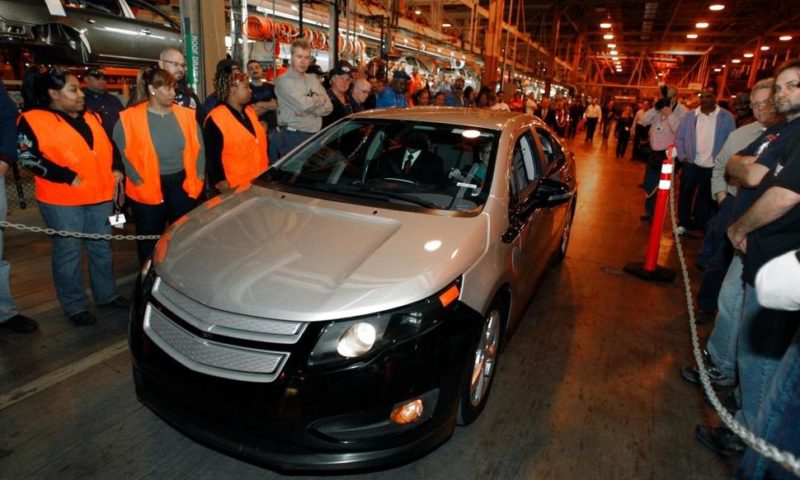General Motors’ planned shutdown of its Detroit-Hamtramck plant would leave only one auto assembly factory in the city, but the closure and job losses are not expected to stall-out Detroit’s remarkable comeback.
DETROIT — General Motors’ planned shutdown of its Detroit-Hamtramck plant would leave only one auto assembly factory in the city known for “putting America on wheels,” but the closure and job losses are not expected to stall-out Detroit’s comeback since its 2014 bankruptcy exit.
Experts say a more tech-driven and medical industry economy is moving Detroit further from a reliance on manufacturing and that GM’s downsizing in the name of cost-cutting and investment in autonomous and electric vehicles won’t hurt as much as past mass layoffs and plant closings.
Detroit once was home to about a dozen massive assembly plants. A Fiat-Chrysler facility on the east side would be the last if GM closes its Detroit-Hamtramck plant. About 1,500 people work at the GM plant while Fiat-Chrysler’s Jefferson Avenue plant employs about 5,000. Fiat-Chrysler reportedly plans to reopen a former engine plant on the city’s east side to make Jeep Grand Cherokee SUVs with three rows of seats starting with the 2021 model year.
“Manufacturing is now a tech industry — you don’t have to hire as many people to make as much stuff,” said Ned Staebler, president and chief executive of the small business incubator TechTown Detroit. “It’s not just General Motors. Every major OEM (original equipment manufacturer), major manufacturer is going through similar processes. It’s a trend that is going to continue.”
GM wants to close four facilities in the United States and one in Canada. Nearly all of the 8,000 white-collar jobs GM expects to cut company-wide would be at the automaker’s technical center just north of Detroit in Macomb County’s Warren.
Some of the 3,300 global blue-collar job losses would come from the Detroit-Hamtramck plant and a transmission facility in Warren.
The jobs account for only .2 percent of local county employment “muting the immediate effect of the plant closures,” Moody’s Investors Service said in a report.
That means there is less reliance on those jobs and plants to supply tax dollars needed to help pay for city services and fill out Detroit’s operating budget.
But, Moody’s wrote, the impact could grow “as GM reduces salaried employees, if reduced production hurts ancillary suppliers or if there is a broader slowdown in the industry.”
Detroit will experience some loss of tax revenue from the plant and people working there, said law professor Anthony Sabino of the Tobin College of Business at St. Johns University in New York.
Owners of shops and restaurants that catered to those workers will be impacted, too.
“This will not derail the (city’s) 21st century renaissance. They are working from a solid foundation. If this had happened prior to the city’s reorganization it could have been far more harmful,” Sabino said.
Detroit was about $12 billion in debt before filing for bankruptcy in 2013. Much of that was erased or restructured allowing the city to improve services, like police and fire, and invest in neighborhoods.
Detroit’s general fund balance was about $595 million at the end of the 2017 fiscal year, compared to a deficit of about $73 million that the city faced at the end of the 2013 fiscal year following years of a plummeting population and tax base.
A $36 million operating surplus was expected for the fiscal year 2018.
A 30-year jobs forecast by the Southeast Michigan Council of Governments forecasts manufacturing jobs in Detroit falling from 23,000 three years ago to 16,000 by 2045. Over that same time, professional and technical services, corporate headquarters, administrative, support, waste services and health care jobs are expected to rise.
Preliminary figures from the U.S. Bureau of Labor Statistics pegged unemployment in Detroit in September at 7.9 percent. While this is still well above the U.S. rate of 3.7 percent, Detroit’s unemployment has been dropping since January 2014 when it was nearly 18 percent. Detroit’s unemployment rate was 28.9 percent in June 2009.
Preparing Detroit’s workforce for non-manufacturing jobs is one of the next hurdles.
Mayor Mike Duggan has said more residents are enrolling in Detroit At Work free training programs. The programs offer training and certifications for jobs that include information technology, truck driving, health careers, computer networking and culinary arts.
But many people in the city are not prepared for tech-related jobs that are in Detroit or on the way, said Ida Byrd-Hill, president of Detroit-based Uplift Inc. which provides computer programming language training.
“A lot of the training programs have not really reached out to women or people of color,” said Byrd-Hill, who added that funding has been limited for local tech-training providers.
Companies are looking for more educated and tech savvy workers, especially those with critical thinking, communications, collaborating and team building skills — someone who is “able to think critically about when to use the appropriate piece of technology,” said TechTown’s Staebler.
With Ford also considering thousands of white-collar cuts, Detroit-area auto industry workers may find it difficult to find new jobs or match their salaries if they go to other industries, said David Kudla, CEO of Mainstay Capital Management in Grand Blanc, Michigan, which advises many auto industry employees. “You’re going to be going out in a marketplace where everybody is cutting back,” he said.
Those with skills in developing autonomous or electric vehicles will have an easier time finding work, Kudla said.
He suggests that workers cut expenses and build savings to be ready in case of layoff.
Still, there’s a human element to a possible Detroit-Hamtramck closure, assembly line worker Dnitra Landon told the Detroit Free Press.
“I know you’re a big business, but what about the people who make you a big business?” Landon, 55, said of GM. “Everybody in here is a survivor and we’re going to survive no matter what happens.”

